nLab bireflective subcategory
Context
Category theory
Concepts
Universal constructions
Theorems
Extensions
Applications
Notions of subcategory
Contents
Idea
By a bireflective subcategory one might mean:
-
A subcategory which is both reflective and coreflective — i.e. a fully faithful functor possessing both left and right adjoints: (reflective localization and coreflective localization).
Such subcategories are called essential localizations by Kelly & Lawvere (1989), following the terminology of essential geometric morphisms from topos theory, see also at level of a topos.
The adjoint pair is then an adjoint modality; see there for more.
-
More specifically, one may in addition ask that , hence that the subcategory inclusion has an ambidextrous adjoint .
Such subcategories are called quintessential localizations by Johnstone (1996).
The corresponding (co-)monad is then a Frobenius monad (see at classical modality).
-
Finally, one may moreover ask that the points-to-pieces transform of a quintessential localization be the identity morphisms.
This strong form of the notion is the case actually called bireflective subcategories by Freyd et al. (1999).
Definition
Definition
A full subcategory-inclusion
is bireflective in the sense of FOPTST99, Def. 8 iff
(1.) the inclusion has an ambidextrous adjoint
(2.) such that for all the counit of the right adjunction followed by the unit of the left adjunction (the points-to-pieces transform) equals the identity:
Remark
The first clause in Def. does not in general by itself enforce the second clause. A counter-example is given in FOPTST99, Rem. 12.
However, the second clause does follow automatically when is a Cauchy-complete category (Johnstone (1996)).
Remark
In the other direction, the second clause in Def. implies that
is an idempotent natural endomorphism, exhibited as a split idempotent.
Proposition
Given a category , its bireflective subcategories (Def. ) are in correspondence with the split idempotent natural endomorphisms on with specified splitting, i.e.
with
Concretely, from a split idempotent on we recover the Frobenius monad as follows:
(RFL21, Lem. 7.7)
Proof
By naturality of the transformation
and using (1) we get the first statement:
The second follows analogously.
Proposition
Given a split idempotent transformation as in Prop. , becomes
-
an idempotent monad by setting
-
an idempotent comonad by setting
Proof
For the associativity of the monoid product we need to show the commutativity of
By functoriality of this follows from the commutativity of
which holds by naturality of .
The other claims follow similarly.
Modal type theory
A modal type theory for bireflection modalities has been proposed in Riley, Finster & Licata (2021), Riley (2022).
We show the inference rules which these authors propose to add to plain intuitionistic type theory for encoding the presence of a bireflection classical modality on the type system, and we show corresponding categorical semantics via commuting diagrams in an interpreting locally cartesian closed category (a more syntactic semantics is indicated in RFL21, Sec. 7, esp. Fig. 6).
Remark
Given a bireflection as above, then for we obtain a monad on the slice category, to be denoted
by setting
Remark
Beware of some non-obvious properties of the following type-theoretic syntax:
-
There is an asymmetry in the meaning of :
An underline of a context denotes application of , but an underline of a type in context only means its pullback along the counit . The idea is that underlines indicate dependency on -modal variables, to be distinguished of a type itself being -modal or not.
-
The syntactic symbol “” is not exactly interpreted as the bireflective monad of that name. Rather:
-
An unadorned “” in the syntax interprets, in context , as the relative monad
-
The combination is what actually interprets as (2).
This transpires syntactically in RFL21, Cor. 2.14; Riley22, Cor. 1.1.16, and semantically in (3) below.
-
The list of inference rules and their categorical semantics (first the axioms then derived rules):
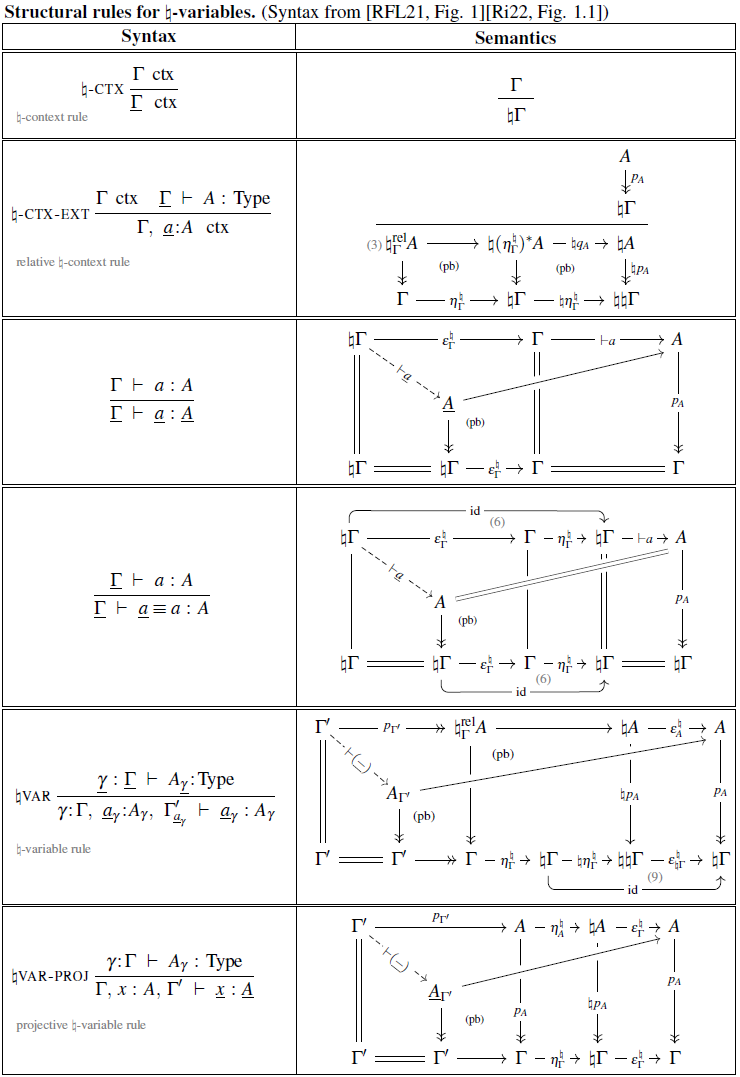
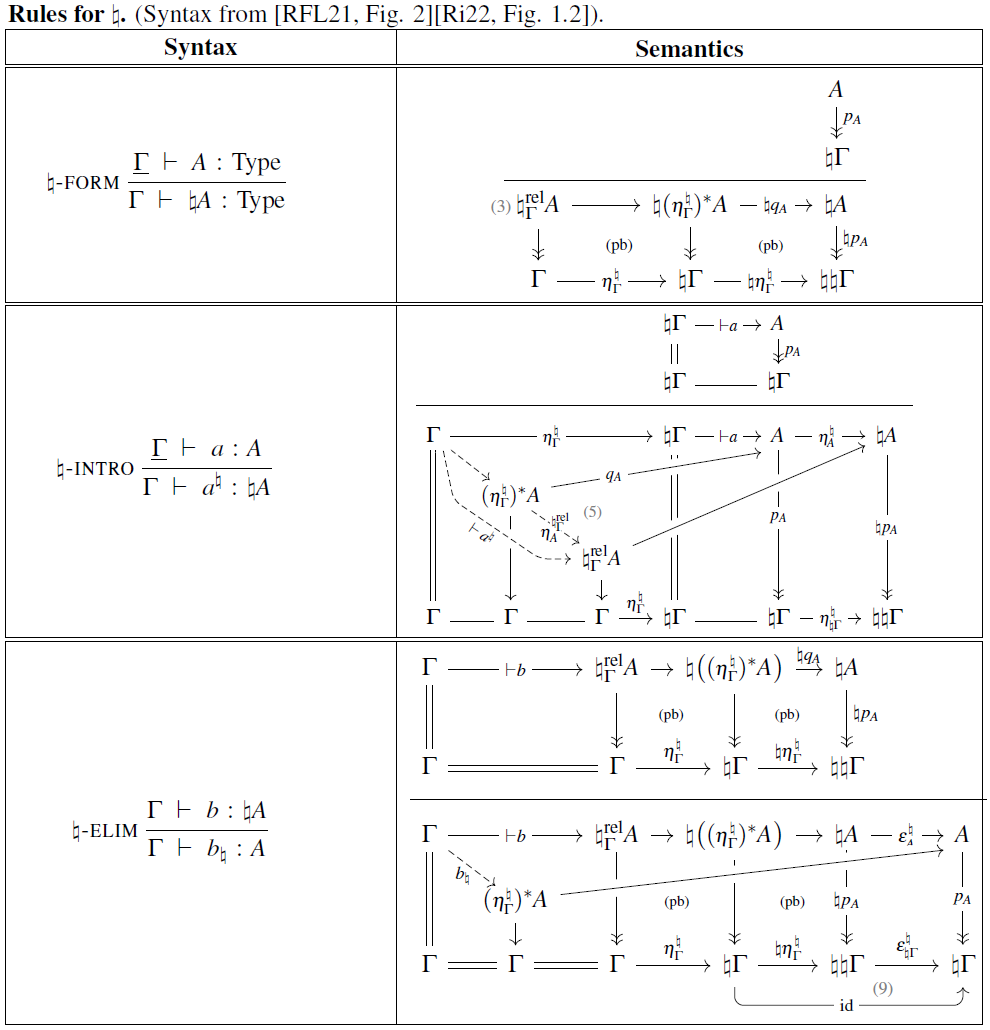
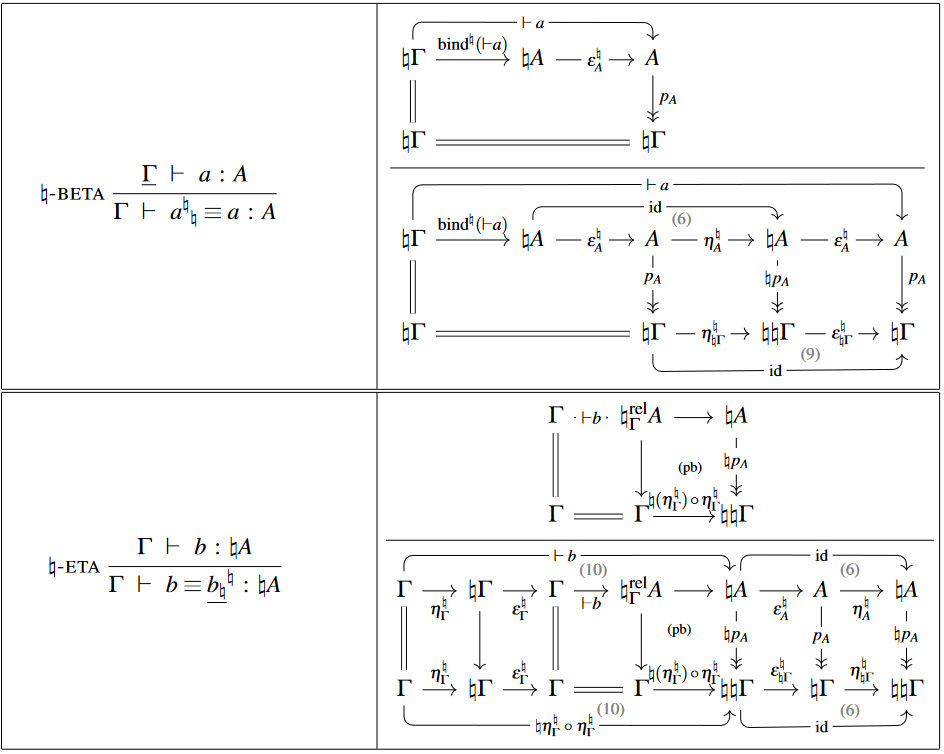
Using these ingredients, one finds that the function is interpreted simply as postcomposition with the -naturality square:

With this, one finds the following rule for respecting dependent pair types:
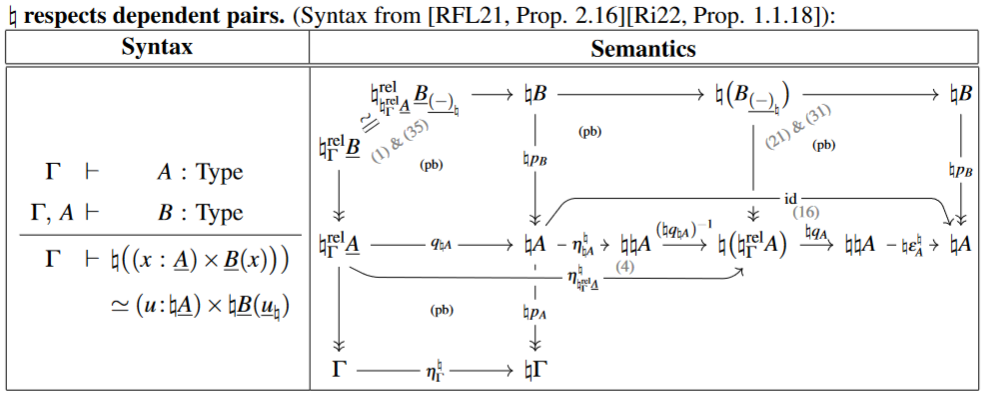
Using this one finds that every type is the dependent sum type of its fiber linear types (NB: we show 1-categorical semantics, interpreting identification types as diagonal morphisms):
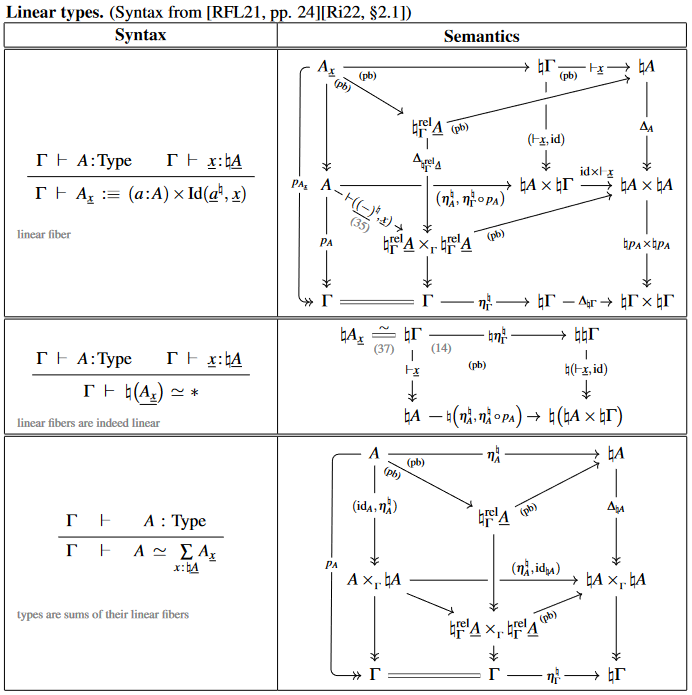
Examples
Example
(spaces among retractive spaces)
Let be the category of retractive topological spaces (or just of Sets), i.e. the category of diagrams in Top (Set) of the form such that . Then the functor
is a bireflective subcategory inlusion (Def. ) with ambidextrous adjoint given by
Example
(zero-vector bundles among all vector bundles)
For any ground field, let be the category VectBund of vector bundles over Sets, hence of indexed vector spaces. Then the functor
which sends any set to the zero vector bundle over is a bireflective subcategory in the sense of Def. .
Example
(zero-spectrum bundles among all parameterized spectra)
Let denote the -category of parameterized spectra over varying -groupoids (the tangent -category of ). Then the inclusion
given by sending to the zero-spectrum bundle over ought to count as a “bireflective sub--category” (cf. here at infinitesimal cohesion).
A model category-presentation of this situation by a (left and right) Quillen functor to a model structure for parameterized spectra underlying which is a bireflective sub-1-category inclusion (Def. ) may be recognized in Hebestreit, Sagave & Schlichtkrull (2020), Lem. 3.19, there incarnated as the canonical inclusion
of -spaces into symmetric spectra internal to retractive spaces (Exp. ).
An analogous statement is in Braunack-Mayer (2019), Cor. 2.45.
Related concepts
References
On subcategory inclusion which have both a left and a right adjoint (essential localizations):
- G. M. Kelly, F. W. Lawvere, On the complete lattice of essential localizations, Bull. Soc. Math. Belg. Sér. A 41 (1989) 289–319 [pdf]
On subcategory inclusions with ambidextrous adjoints (quintessential localizations):
- Peter Johnstone, Remarks on Quintessential and Persistent Localizations, TAC 2 8 (1996) 90-99. [pdf, 2-08]
On subcategory inclusions with ambidextrous adjoints whose points-to-pieces transform is the identity (actual bireflective subcategories):
- Peter Freyd, Peter O’Hearn, A. John Power, M. Takeyama, Ross Street, Robert D. Tennent, Bireflectivity, Theoretical Computer Science 228 1–2 (1999) 49-76 [doi:10.1016/S0304-3975(98)00354-5]
Discussion of a modal type theory for bireflective modalities, in a context of linear homotopy type theory:
-
Mitchell Riley, Eric Finster, Daniel R. Licata, Section 7.1 in: Synthetic Spectra via a Monadic and Comonadic Modality [arXiv:2102.04099]
-
Mitchell Riley, A Bunched Homotopy Type Theory for Synthetic Stable Homotopy Theory, PhD Thesis (2022) [doi:10.14418/wes01.3.139, ir:3269, pdf]
Last revised on April 17, 2023 at 11:16:58. See the history of this page for a list of all contributions to it.